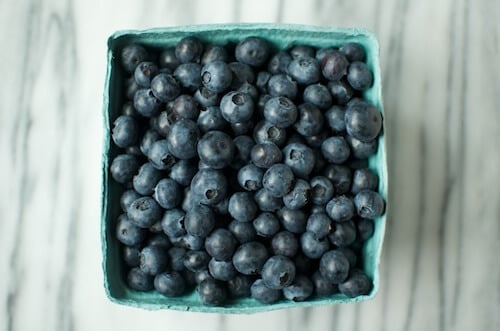
Want to Save this Recipe?
Enter your email below & we'll send it straight to your inbox. Plus you'll get great new recipes from us every week!
This post is by Marisa McClellan, creator of the popular blog Food in Jars. Marisa is a food writer, canning teacher, and dedicated farmers market shopper who lives in Center City Philadelphia. She is the author of Food in Jars: Preserving in Small Batches Year-Round and Preserving by the Pint: Quick Seasonal Canning for Small Spaces. Find more of her jams, pickles, and preserves (all cooked up in her 80-square-foot kitchen) on her website, Food in Jars.
I am so delighted to be here sharing my small batch recipe for Honey Sweetened Blueberry Jam. Most people think that making jam has to be a giant process that takes all day, uses multiple pounds of sugar, and dirties every utensil in the kitchen. But there's another faster way that it can be done with honey in place of sugar, and it's endlessly delicious.
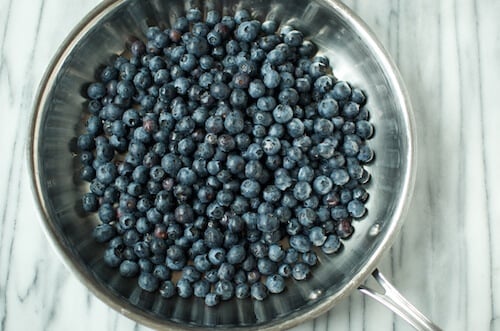
The secret is in the small batch, cooked in a low, wide pan like a frying pan or a high sided skillet. The pan creates a lot of surface area, which means that you can cook the moisture out of the fruit more quickly and create a nice, solid set rapidly and without the amounts of sweetener that are typically called for in jam making.
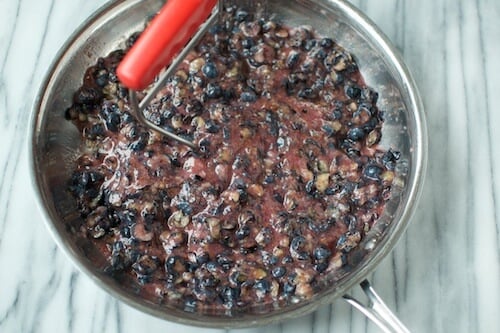
You start with a quart of blueberries. If you're going by weight, it's an even 1 ½ pounds. Wash them well and then tumble them into a low, wide pan. You want to pick one made from a non-reactive metal like stainless steel, enameled cast iron, or anodized aluminum. Use a potato masher (or employ a small child to help!) and mash the berries.
Add ⅔ cup of honey (if you have a kitchen scale, plunk the pan right on top of it, zero out the weight, and pour in 8 ounces of honey). Stir in the juice from half a lemon, put the pan on the stove and bring it to a boil.
Once it boils, you cook the fruit for about ten minutes until it thickens. You can tell that it's done when you can draw a line through the jam with your spatula and the space stays open for a moment.
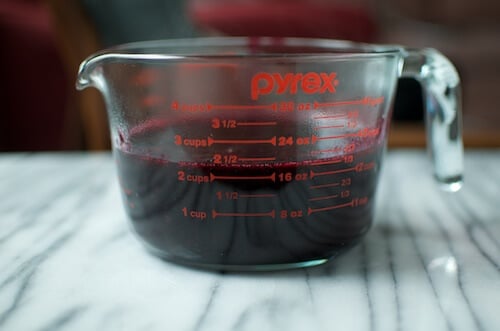
Once it's done, you have two choices. You can funnel it right into a jar, let it cool, and then stash it in the fridge for immediate consumption. It will keep there for three to four weeks. Or, you can divide it between a couple clean, hot jars, apply new lids and rings, and process them in a boiling water bath canner to make the jars shelf stable.
If you do go through this extra step, know that the jars don't have to be sterilized before filling. They just need to be clean and hot. The boiling water bath will serve as the sterilization step just fine.
I like to use an asparagus steamer as a tiny batch canning pot because you can stack a couple wide mouth half pints right inside the wire cage and it doesn't take much time or energy to bring to a boil. However, any stock pot will do, as long as you slip a rack under the jars (like a round cake cooling rack or even a dish towel or layer of mason jar rings will do) to keep them from rattling against the bottom of the pot. A pasta pot with straining insert makes a really good canning pot.
If you're looking for more detail about setting up your own canning post, I have a post on my site that details the process.
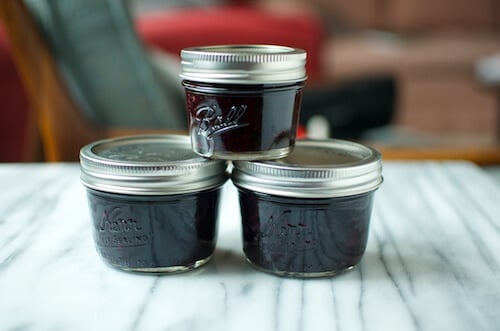
This same technique will work with nearly all fruit (except apples don't do well when treated like this), but do give it a try with strawberries, or later in the summer with apricots, nectarines, or plums. You can also vary the flavorings. As you'll see, the batch I made was quite basic, but you can add a little spice, a bit of vanilla bean, or even a sprig of fresh mint or basil (just pull it out at the end of cooking).
We use it in our Lemon Blueberry Bread!
FAQ
Q: Can I make this recipe with fruits other than blueberries?
A: Yes! However, blueberries have a good deal of pectin naturally, so you may have to cook other fruits a bit longer in order to get a satisfyingly thick consistency.
Q: Can I make this jam with frozen fruit?
A: Yes! Defrost the fruit fully before combining it with the honey. Take note that it may need an additional minute or two of cooking, because frozen fruit will release more liquid than fresh.
Q: Can I skip the boiling water bath process and just freeze this jam?
A: Yes! Funnel it into freezer containers and leave about an inch of space up at the top to allow for expansion. Let the jam cool to room temperature before placing the containers in the freezer. If you choose to freeze in glass jars, make sure that you use jars that have straight sides, as there's less risk of breakage that way.
Q: Can I double or triple this recipe?
A: I don't recommend it. The reason this jam works so well without any additional pectin has everything to do with the small batch size. If you increase the volume in the pan, that makes it harder for the fruit to cook down efficiently. If you have a very, very large, wide pan, you can try a double batch.
If you want to make much larger batches of honey sweetened jam, I recommend looking into Pomona's Pectin. It's a natural product that allows you to get a really satisfying set with any sweetener. There's a really terrific cookbook called Preserving with Pomona's Pectin that will give you all the detail you need.
Q: Can I use something other than lemon juice?
A: For those of you who can't have citrus, try using a tablespoon of apple cider vinegar in place of the lemon. It will balance the flavor in the same way.
Q: How much does this recipe yield?
A: You should get between 2 and 3 half pints from a batch this size. The yield will vary a bit depending on how much water is in the fruit and how long you cook it.
Q: Can I reduce the amount of honey?
A: Yes. However, know that the honey isn't just a sweetener when you make jam. It also plays a role in helping the jam set up. So if you reduce the honey, you may have to cook it a bit longer to get it to be truly jammy. And of course, the yield will be less because you've reduced the total starting volume.
Q: Can I use agave instead of honey?
A: Yes! Agave will work just as well.


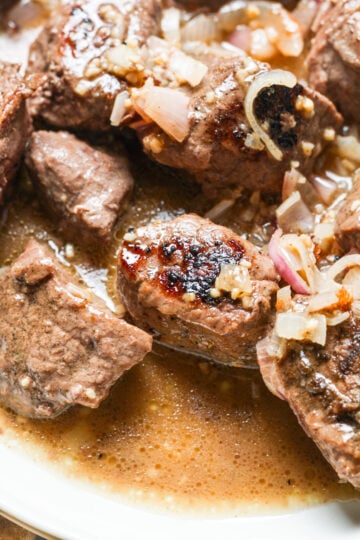



Amber says
Hi I would like to know if I can add gelatine granules and whether I can still boil the jars afterward?
I would also like to know if I can add the honey afterwards, so that I don't lose nutrients of honey.
Suze says
Love this recipe. Happy with small batch. Great way to use up extra fruit. Love the simplicity of ingredients!!!!!
Jenn says
I made this with 2lbs of frozen blueberries and eyed the honey until i acquired the desired sweetness level. It took FOR EVER to thicken. Which was expected given that I had altered the recipe. Just letting y'all know that if you're making this w/ frozen bluebs or altering your honey amount and feel like it's not working, I'm here to cheer you on! It will thicken and it will be amazing! Mine took about 25 - 30 min! Don't give up, you can do it! lol
100 Days Admin says
Glad to hear that it worked out great for you and thank you for letting us know your experience so it'll help others. - Nicole
Heidi says
Made this with raspberries! Delicious and so easy!
100 Days Admin says
That's awesome! Glad you liked it. - Nicole
opal says
your measurements were off about the honey. 2/3 cup = 5.33 ounces not 8 ounces... added 8 ounces of honey looking at the recipe while distracted. it only tastes like honey now.
Rebekah says
Honey is heavier than water.
1cup water = 8oz, but 1cup honey = 12oz.
So 2/3c = 8oz for honey is correct.
Holly says
I just made this with fresh picked blueberries. Giving some to friends who love blueberry jam, but I had to try it, too. Blueberry jam has not been a favorite of mine...but this...well...wow!
100 Days Admin says
So glad to hear you love it. Hope your friends enjoy it, too. - Nicole
Donna Keim says
This recipe is exactly what I was looking for. We grow our own fruit and have honey bees so it was perfect. Loved the simple and natural ingredients and being able to freeze it is a bonus. Thanks for the recipe
Cheryl says
This recipe is simple and fantastic. I cut the honey to less than half and it was perfectly sweet and it thickened like jam beautifully. I used frozen organic blueberries from Costco and am so pleased because I can make this fresh all winter!!!
Brandi Schepers says
Hi there! Would this recipe work well for Saskatoon berries? Just wondering about the seediness and taste of them for it:)
Tamara says
Cooking with honey is toxic. Heating honey kills all the nutrients and heating changes the nature of the honey causing it to become like glue in the gut, causing digestive issues. It does not matter how clean or real a food is if it is not prepared properly it can cause issues within the body. A cook book called Wise Traditions tells why and how to properly prepare real food for max nutrition.This site does A good job of show casing real food but does not do a good job on showing how to properly prepare it.
Ann Balough says
This is myth. Toxic= nerve agent. Honey is primarily glucose & fructose. Heat will not damage it! In fact honey does not spoil. Ever.
this is basic organic chemistry/food science.
Tamara says
Not a myth. If you do your research you will find out. There have been studies done to prove it is unwise to cook with honey. Check out Ayurveda, Weston A. Price,Wise Traditions all of these along with many other scientific studies will explain why. Besides heating honey kills all the beneficial enzymes giving it no nutritional value making it no different than white sugar. Why spend all that money on expensive honey then kill all benefits by heating. There are wiser sweeteners to cook and bake with as all real foodies know.
Saneda Deborah says
Heating raw honey above 40 degrees Celsius is not considered toxic by mainstream medical sources. It can destroy many of the beneficial nutrients and enzymes fund in raw honey, but consider that most grocery store honey has been pasteurized above this heat.. It is considered considered toxic by Maharishi Ayurveda, a controversial system of alternative medicine, one not generally accepted by Western scientists. When raw honey is heated or aged, it creates 5-Hydroxymethyl-2-furancarboxaldehyde (HMF).
HMF has been reported to have negative effects on human health, such as cytotoxicity toward mucous membranes, the skin and the upper respiratory tract; mutagenicity; chromosomal aberrations; and carcinogenicity toward humans and animals. Many food items sweetened with high fructose corn syrups, e.g. carbonated soft drinks, can have levels of HMF between 100 and 1,000 mg/kg.
Conversely, HMF, which is converted to a non-excretable, genotoxic compound called 5-sulfoxymethylfurfural, is beneficial to human health by providing antioxidative, anti-allergic, anti-inflammatory, anti-hypoxic, anti-sickling, and anti-hyperuricemic effects.
HMF is present in many of our foods, from garden onions, tomatoes, numerous plant species, tobacco, processed foods, and coffee - and the levels in these foods are generally higher than found in honey that has been treated. However, the levels necessary for these effects to be significant are unclear. One article I found from the NIH said "Hence, no relevance for humans concerning carcinogenic and genotoxic effects can be derived. The remaining toxic potential is rather low."
A more recent article states that there is. not enough research at present to determine a safe daily intake of HMF. Chem Cent J. 2018; 12: 35. However,
Published online 2018 Apr 4. doi: 10.1186/s13065-018-0408-3
A final note on honey in general - honey can be contaminated with heavy metals such as lead, arsenic, mercury and cadmium. Honey produced from the nectar of Rhododendron ponticum contains alkaloids that can be poisonous to humans, while honey collected from Andromeda flowers contains grayanotoxins, which can cause paralysis of limbs in humans and eventually leads to death. I think that as with any food, moderation will keep you safe here. It would appear that some cooked honey is not as bad for you as some coffee and a sugary roll. And the honey we get in the US is generally not going to be collected from the above mentioned plants - but if in doubt - ask your honey retailer. Likely,in the latter instance, someone would have been the canary in the coal mine and no honey from that source would be sold.
Tamara says
I am fully aware and educated in all the info you provided. Because of my knowledge it does bother me that so many people think they are getting healthier by using grocery store honey and also cooking with honey. Some people even buy the very good quality raw honey then destroy it by cooking it thinking they are doing something that adds to their nutrition, when in fact they are in essence ending up with food that is sweetened with nothing no different than white sugar. Just want people to realize this cooking honey method is not any healthier than sugar.
Tamara says
It's not bull. It's okay that you cook with honey, just know when heated it's not any different than sugar. Study the differences between raw honey and pasteurized( heated ) honey and you will understand why heated honey no longer has its nutrients. Not trying to be mean, you just need to learn about honey to understand what I'm talking about. People pay for expensive raw honey to cook with(believing their making a healthier choice) not having the wisdom to know once they've heated(pasteurized) it is no different than white sugar. Just don't waste your money on expensive raw honey, buy the cheap stuff if going to cook with it. So important to be a knowledgeable food consumer. It's bull to believe the claims that heated honey is healthier than white sugar.
Scott Valin says
Calm down Debby, its a recipe, not a lab analysis,etc us eat in peace. On a brighter note, great recipe, I love it on my roundup enhanced wheat muffins and my carcinogenic peanut butter and jelly sandwiches. Eat up!! Nobody gets out alive
Georgia Underwood says
Bull! I have cooked with honey for years.
Tamara says
It's bull to believe the claims that cooking with honey is healthier than white sugar. It's perfectly fine to cook with honey if you choose, just buy the cheap stuff instead of the expensive raw honey since heating honey kills all beneficial nutrients and that's no bull!